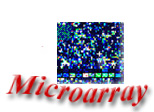



 |
 |
 |
 |
The Facility is located at : |
Step 1: All investigators who wish to pursue a project through the Microarray Facility must first meet with the Director and the Manager to ensure proper experimental design and clear understanding of sample processing through the facility.
Step 2: It is strongly recommended that you isolate RNA using TriZol followed by Qiagen’s RNeasy kit. Submit RNA samples for quality assessment using an RNA Quality Assessment Order Form (available at the facility or online), to the intake area of the facility (HSRF 305). Information required on the form includes RNA concentration, 260/280 ratio, RNA source, and isolation method. Concentration is critical since the dynamic range of the 2100 Bioanalyzer is 25-500 ng/ul. We require 2.5 ul of clean RNA for sample assessment. The facility staff will analyze results and a report including electropherograms will be given back to the investigator and recommendations will be made on how to proceed further.
Step 3: Submit RNA samples for Target prep. You have two options here: the facility staff or the investigator can perfom the target preparation. If the investigator wants the facility to perfom the target prep, a Target Prep Form will need to be submitted in the intake area (HSRF 305). Information required is RNA concentration, A260/280 ratio, and prior RNA quality assessment. 40ug of total RNA is recommended for each target preparation. RNA and fragmented cRNA will be run on an agarose gel to ascertain the quality. If you choose to prepare the target yourself, please follow the guidelines for performing this procedure.
Step 4: Test Chip Hybridization and Scanning. We recommend a test chip be run for each target preparation to assess the efficiency of the cDNA reaction and quality of the target prep intensities before moving on to the more expensive probe arrays. An experiment report will be provided to the investigator.
Step 5: Hybridization and scanning of Gene Chip arrays. An experiment report will be provided to the investigator along with the .exp, .dat, .cel, and .chp, and absolute text files on CD. We suggest that you also make your own back-up. A report summarizing all steps, quality control checks, and results form will be provided to the user.
Step 6: Detailed data analysis is the responsibility of the investigator. A computer workstation is available at the facility for data analysis using Microarray Suite V.5, Micro Database, and Data Mining Tool software packages. Further data analysis options using Gene Spring software are available at the Bioinformatics core.
Check the quality and purity of your RNA. Your A260/A280 ratio should be >1.7. A quality estimate is done by running a gel and getting the 28S to 18S rRNA band ratio. It should be about 2. A simple visualization of a gel to see if your 28S and 18S bands look OK is not adequate. The facility will perform quality check on your RNA with Agilent Bioanalyzer at a cost (see below). Please do not provide us the RNA samples that you have not analyzed, unless you are extremely limited by its availability.
Measure your cRNA yield, you should routinely obtain >40ug cRNA if starting from 10ug total RNA (this is after adjusting your yield by subtracting starting RNA material).
Run your cRNA in a gel to make sure that you have a smear distributed from ~1kb to ~6kb. After fragmentation, run another gel to make sure that your cRNA has been properly fragmented, sizes should range from 100 to 250 bp. We are requiring that you submit a gel picture of your unfragmented and fragmented cRNA for quality control purposes.
The UVM Microarray Core Facility reserves the right to use all data from hybridizations performed in the facility for the purpose of assessing quality of data generated in the facility and for the development of quantitation and analysis tools. The data will be used in a strictly anonymous.